
The Lavochkin La-7 was a piston-engined single-seat Soviet fighter aircraft developed during World War II by the Lavochkin Design Bureau. It was a development and refinement of the Lavochkin La-5, and the last in a family of aircraft that had begun with the LaGG-1 in 1938. Its first flight was in early 1944 and it entered service with the Soviet Air Forces later in the year. A small batch of La-7s was given to the Czechoslovak Air Force the following year, but it was otherwise not exported. Armed with two or three 20 mm (0.8 in) cannon, it had a top speed of 661 kilometers per hour (411 mph). The La-7 was felt by its pilots to be at least the equal of any German piston-engined fighter. It was phased out in 1947 by the Soviet Air Force, but served until 1950 with the Czechoslovak Air Force.
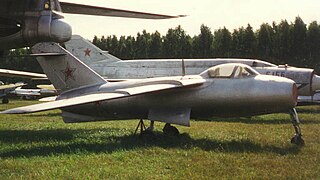
The Lavochkin La-15, was an early Soviet jet fighter and a contemporary of the Mikoyan-Gurevich MiG-15.

The Lavochkin La-9 was a Soviet fighter aircraft produced shortly after World War II. It was one of the last piston engined fighters to be produced before the widespread adoption of the jet engine.

The Lavochkin La-11 was an early post-World War II Soviet long-range piston-engined fighter aircraft. The design was essentially that of a Lavochkin La-9 with additional fuel tanks and the deletion of one of the four 23 mm Nudelman-Suranov NS-23 cannons. Like the La-9, the La-11 was designed to be a low to medium-altitude general-purpose fighter, although the additional fuel tanks were added with the intent of employing the La-11 in the escort fighter role.

The Tupolev ANT-40, also known by its service name Tupolev SB and development co-name TsAGI-40, was a high speed twin-engined three-seat monoplane bomber, first flown in 1934. The Tupolev design was advanced but lacked refinement, much to the dismay of crews, maintenance personnel, and Stalin, who pointed out that "there are no trivialities in aviation".
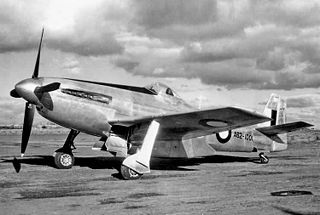
The CAC CA-15, also known unofficially as the CAC Kangaroo, was an Australian propeller-driven fighter aircraft designed by the Commonwealth Aircraft Corporation (CAC) during World War II. Due to protracted development, the project was not completed until after the war, and was cancelled after flight testing, when the advent of jet aircraft was imminent.

The Klimov M-105 was a V12 liquid-cooled piston aircraft engine used by Soviet aircraft during World War II.

The VL Humu (Whirlwind) is a Finnish fighter aircraft, designed by Valtion lentokonetehdas in 1944, and based on the American Brewster F2A Buffalo.

The VL Pyörremyrsky ("Hurricane") was a Finnish fighter, designed by DI Torsti Verkkola at the State Aircraft Factory for service with the Finnish Air Force in World War II. The war ended before the type's first flight and only a prototype was built.
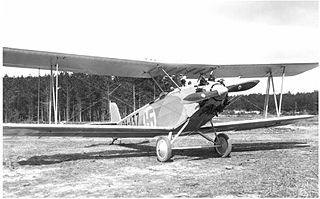
VL Paarma was a Finnish biplane, two-seat trainer aircraft, designed by the State Aircraft Factory for use with the Finnish Air Force.
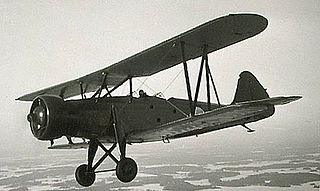
The VL Tuisku was a Finnish trainer aircraft designed in the 1930s. It was a two-seat, single-engined biplane with a welded steel framework, covered with fabric. 30 were produced for the Finnish Air Force and served from 1935 to 1949.

VL Viima, constructed by the State Aircraft Factory is a Finnish two-seat, biplane trainer used by the Finnish Air Force from the late 1930s to the early 1960s. After military service, several were released into civil use.

VL Pyry was a Finnish low-winged, two-seated fighter trainer aircraft, built by the State Aircraft Factory for use with the Finnish Air Force. The Pyry was in use from 1939 to 1962. The aircraft was a mixed construction of wood, steel, fabric, and duraluminium.

VL Kotka ("Eagle") was a Finnish two-seat, biplane maritime patrol aircraft, designed and built by the Valtion lentokonetehdas or VL. It was meant as a cheaper replacement for the outdated IVL A.22 Hansas that were in service with the Finnish Air Force.

VL Sääski II was the first series-produced aircraft designed in Finland. The aircraft was built by the State Aircraft Factory and was a two-seat, biplane, single-engine trainer constructed out of wood.

The Lavochkin-Gorbunov-Gudkov LaGG-3 was a Soviet fighter aircraft of World War II. It was a refinement of the earlier LaGG-1 and was one of the most modern aircraft available to the Soviet Air Force at the time of Germany's invasion in 1941. Compared to its opponents the LaGG-3 was underpowered and, despite its wooden construction, overweight. It was unpopular with Soviet pilots, but despite this, at one point in the war, on average 12 LaGG-3s were being completed daily and 6,528 had been built in total when production switched to the Yak-3 in 1944. The LaGG-3 was steadily improved, forming the basis for the more successful La-5 and La-7.

The Valmet Tuuli was a trainer aircraft, developed for the Finnish Air Force by the State Aircraft Factory. The aircraft was to be produced in 3 different versions. The last version, Tuuli III was redesigned from scratch, and is basically an entirely different aircraft.
The Lavochkin-Gorbunov-Gudkov LaGG-1 was a Soviet fighter aircraft of World War II. Although not very successful, it formed the basis for a series of aircraft that would eventually become some of the most formidable Soviet fighters of the war.

Valtion lentokonetehdas was a Finnish aircraft manufacturing company that was founded on 23 February 1928 from the IVL or I.V.L. factory, founded in 1921.
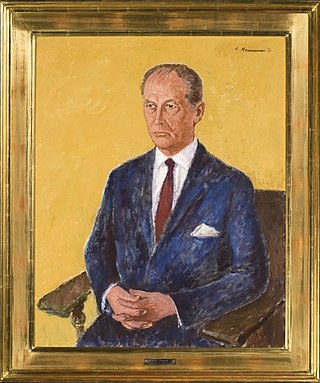
Torsti Rafael Verkkola was a Finnish aircraft designer, researcher and professor.





















